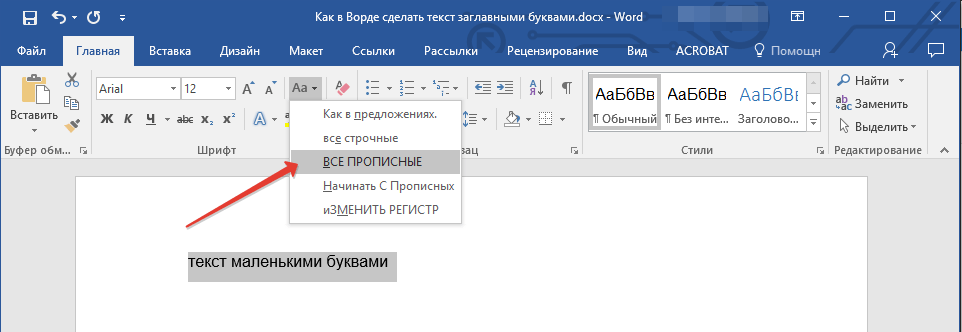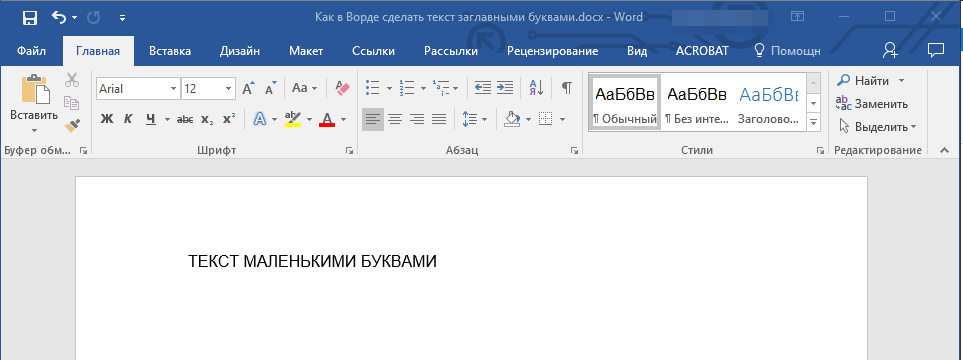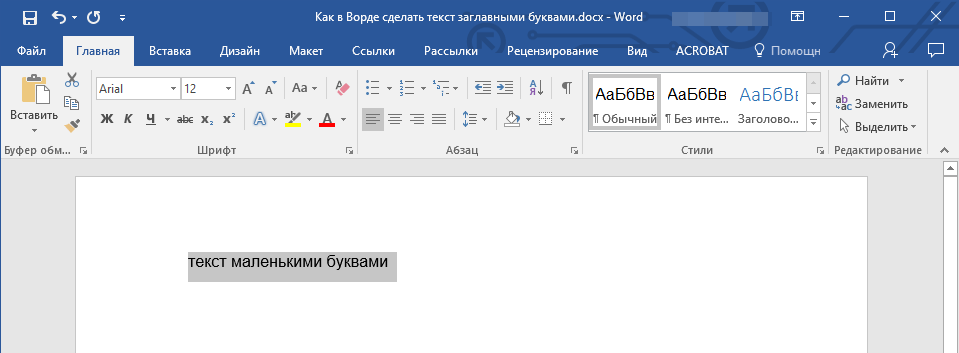You can change the capitalization, or case, of selected text in a document by clicking a single button on the Home tab called Change Case.
Change case
To change the case of selected text in a document, do the following:
-
Select the text for which you want to change the case.
-
Go to Home > Change case
.
-
Do one of the following:
-
To capitalize the first letter of a sentence and leave all other letters as lowercase, click Sentence case.
-
To exclude capital letters from your text, click lowercase.
-
To capitalize all of the letters, click UPPERCASE.
-
To capitalize the first letter of each word and leave the other letters lowercase, click Capitalize Each Word.
-
To shift between two case views (for example, to shift between Capitalize Each Word and the opposite, cAPITALIZE eACH wORD), click tOGGLE cASE.
Tips:
-
To apply small capital (Small Caps) to your text, select the text, and then on the Home tab, in the Font group, click the arrow in the lower-right corner. In the Font dialog box, under Effects, select the Small Caps check box.
-
To undo the case change, press CTRL+ Z.
-
To use a keyboard shortcut to change between lowercase, UPPERCASE, and Capitalize Each Word, select the text and press SHIFT + F3 until the case you want is applied.
-
See also
Insert a drop cap
Choose AutoCorrect options for capitalization
Change case
To change the case of selected text in a document, do the following:
-
Select the text for which you want to change the case.
-
Go to Home > Change case
.
-
Do one of the following:
-
To capitalize the first letter of a sentence and leave all other letters as lowercase, click Sentence case.
-
To exclude capital letters from your text, click lowercase.
-
To capitalize all of the letters, click UPPERCASE.
-
To capitalize the first letter of each word and leave the other letters lowercase, click Capitalize Each Word.
-
To shift between two case views (for example, to shift between Capitalize Each Word and the opposite, cAPITALIZE eACH wORD), click tOGGLE cASE.
Tips:
-
To apply small capital (Small Caps) to your text, select the text, and then on the Format menu, select Font, and in the Font dialog box, under Effects, select the Small Caps box.
Small Caps shortcut key: ⌘ + SHIFT + K
-
To undo the case change, press ⌘ + Z .
-
To use a keyboard shortcut to change between lowercase, UPPERCASE, and Capitalize Each Word, select the text and then press fn+ SHIFT + F3 until the style you want is applied.
-
See also
Insert a drop cap
Choose AutoCorrect options for capitalization
PowerPoint for the web supports changing case. See the procedure below.
Word for the web doesn’t support changing case. Use the desktop application to open the document and change text case there, or else you can manually change the casing of text in Word for the web.
-
Select the text you want to change.
-
Go to Home > More Font Options > Change case.
-
Choose the case you want to use.
Updated: 12/30/2021 by
In Microsoft Word, you can use the keyboard shortcut Shift+F3 to change selected text between uppercase, lowercase, and title case.
Selecting a case
- Highlight all the text you want to change. If you want to change the case for the whole document you can use the Ctrl+A keyboard shortcut to select everything.
- Hold down Shift and press F3.
- When you hold Shift and press F3, the text toggles from sentence case (first letter uppercase and the rest lowercase), to all uppercase (all capital letters), and then all lowercase.
Note
If you are using a laptop or an Apple Mac, the function keys may not be enabled without the use of the Fn key. You may need to hold Fn, in addition to Shift, when you press F3.
If you’re not able to get Shift+F3 to work in Microsoft Word 2007 or later, you can try the following option instead.
- In the menu bar, on the Home tab, click the Change Case icon, which has an uppercase ‘A’ and lowercase ‘a.’
- Select the appropriate option from the list of values. For example, if you want to change to all uppercase letters, select the UPPERCASE option. If you want to change to all lowercase letters, select the lowercase option.
Tip
Use our text tool to convert any text from uppercase to lowercase.
I want to convert lower case text to uppercase text in Microsoft Word.
fretje
10.7k5 gold badges39 silver badges63 bronze badges
asked Feb 23, 2010 at 23:40
Wern AnchetaWern Ancheta
6,44226 gold badges105 silver badges147 bronze badges
In Microsoft Office 2007 you can use the Change Case button on the Home tab.
If that is not what you are looking for you will need to add more details to your question.
Gaff
18.4k15 gold badges57 silver badges68 bronze badges
answered Feb 23, 2010 at 23:43
3
When you’ve had caps lock on by mistake, highlight the words you typed and press Shift+F3. Pressing Shift+F3 repeatedly swaps between upper case, title case and lower case.
eg. if you type:
tHIS IS A TEST.
… then select all the text and press Shift+F3:
This IS A TEST.
… then press Shift+F3 again:
THIS IS A TEST.
… and Shift+F3 again:
this is a test.
… and Shift+F3 one last time:
This is a test.
It’s interesting that the behaviour is a little different if there is no full stop (period character) in the selected text. Shift+F3 then capitalizes every word when switching to title case:
This Is A Test
Hope this helps.
Matthew
Arjan
30.8k14 gold badges74 silver badges112 bronze badges
answered Feb 24, 2010 at 12:39
4
Hold Shift when typing?
answered Feb 23, 2010 at 23:46
MDMarraMDMarra
20.5k4 gold badges43 silver badges54 bronze badges
3
Shift+F3 does not work for some strings, like
95ad861b134e39cbd7ecd6c9070a58f4
If you highlight that then hit Shift+F3, nothing happens. You have to either use the Change Case button as shown above or add an extra word, like
95ad861b134e39cbd7ecd6c9070a58f4 test
Then Shift+F3 will cycle through the capitalization options.
If you have a few minutes, write «3D» into Word, highlight it, then hit Shift+F3 a few times. Why do you think this feature was implemented in this manner?
answered Apr 4, 2013 at 14:43
Ed NorrisEd Norris
2732 gold badges4 silver badges10 bronze badges
4
If you highlight that then hit Shift+F3, nothing happens. You have to either use the Change
Case button as shown above or add an extra word, like
Ctrl + Shift + A
answered Sep 30, 2014 at 7:41
Знакома ли вам ситуация, когда вы набираете текст в документе, а затем смотрите на экран и понимаете, что забыли отключить CapsLock? Все буквы в тексте получаются заглавными (большими), их приходится удалять, а затем заново набирать.
О том, как решить эту проблему, мы уже писали. Однако, иногда возникает необходимость выполнить кардинально противоположное действие в Ворде — сделать все буквы большими. Именно об этом мы и расскажем ниже.
Урок: Как в Word сделать маленькими большие буквы
1. Выделите текст, который должен быть напечатан большими буквами.
2. В группе “Шрифт”, расположенной во вкладке “Главная”, нажмите кнопку “Регистр”.
3. Выберите необходимый тип регистра. В нашем с вами случае — это “ВСЕ ПРОПИСНЫЕ”.
4. Все буквы в выделенном фрагменте текста изменятся на заглавные.
Сделать заглавными буквы в Ворде можно и с помощью использования горячих клавиш.
Урок: Горячие клавиши в Word
1. Выделите текст или фрагмент текста, который должен быть написан прописными буквами.
2. Нажмите дважды “SHIFT+F3”.
3. Все маленькие буквы станут большими.
Вот так просто можно в Ворде сделать прописные буквы из маленьких. Желаем вам успехов в дальнейшем изучении функций и возможностей этой программы.
Еще статьи по данной теме:
Помогла ли Вам статья?
Did you know you didn’t need to rely on our title capitalization tool if you use Microsoft Word? Microsoft Word has some basic title capitalization tools that you can use in a pinch if your text is in all caps or has generally messed-up capitalization.
Converting case is really simple in Microsoft Word. If you go to the ribbon option under “Home” for “Change Case” (also found with shortcut ALT+H+7) you’ll find the following options:
- Sentence case: Only the first letter of each sentence is capitalized in sentence case.
- lowercase: Self-explanatory, but this option lowercases all of the letters.
- UPPERCASE: Also self-explanatory, but all the letters are uppercased.
- Capitalize Each Word: This style is also known as title case or First Letter and is the most common capitalization method for titles and headlines.
- tOGGLE cASE: This style will reverse the case of every letter in the selected text. For example, “tHIs IS PoORLy CAPitaLIZED” will change to “ThiS is pOorlY capITAlized”.

Convert Case in Microsoft PowerPoint
PowerPoint has the same capitalization options as Microsoft Word located under the ribbon option “Home” and then “Change Case” (also found with shortcut ALT+H+7). This will make sure all your slide headers use the same capitalization rules.
Change Case in Microsoft Excel
Excel is different from the above two Microsoft products because it is a spreadsheet tool based mostly on formulas and data. However, there are formulas built into Excel that allow for some basic title capitalization.
Converting text to uppercase in Excel
Excel has a built-in formula for converting text to uppercase. It’s simply called “UPPER”.
=UPPER(text)
The formula works by converting a string (or cell reference) between the parentheses to uppercase. You can see how this formula is used in the following screenshot:
Converting text to lowercase in Excel
Excel has a built-in formula for converting text to lowercase. It’s simply called “LOWER”.
=LOWER(text)
The formula works by converting a string (or cell reference) between the parentheses to lowercase. You can see how this formula is used in the following screenshot:
Converting text to title case in Excel
Excel has a built-in formula for converting text to title case. It’s simply called “PROPER”.
=PROPER(text)
The formula works by converting a string (or cell reference) between the parentheses to title case. You can see how this formula is used in the following screenshot:
Conclusion
Overall, Microsoft Office has some great tools for capitalizing titles and text. While they don’t offer checks against the latest style guides, they work pretty well. Go ahead, try using the built-in Microsoft Office capitalization tools!
This post was proofread by Grammarly. Try it — it’s FREE!
Capitalize My Title is a dynamic title capitalization tool used to make sure your titles or headlines use proper capitalization rules according to various style guides include APA, AP, MLA, and Chicago. It also counts your words and checks for grammar issues.

 .
.













